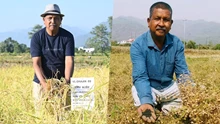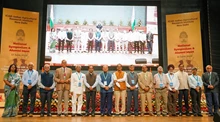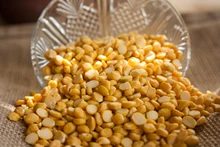
Bael, scientifically known as Aegle marmelos Correa, is a revered fruit indigenous to India. With a multitude of names such as bela, bilva, wood apple and golden apple, it holds a special place in Hindu rituals and ancient texts like the Yajur Veda and Ramayana. Beyond its cultural significance, bael is celebrated for its medicinal properties, with every part of the tree finding use in traditional medicine. Rich in nutrients and bioactive compounds, it serves both culinary and medicinal purposes. Widely distributed across India, particularly in regions like Uttar Pradesh, Bihar, and West Bengal, bael is cherished for its versatility and value in Indian culture and cuisine.
Climate and Soil
-
Bael exhibits natural resilience to withstand high temperatures and minimal soil moisture by shedding its leaves in summer. However, young plants require protection from temperatures below 40°C and desiccating hot winds.
-
It thrives in swampy, alkaline, and stony soils with a pH range of 5.0 to 10.0, including saline, sodic, and sandy wastelands treated with gypsum and pyrite. Bael plants display remarkable hardiness, capable of rejuvenating even after being buried under sand for months and tolerating salinity up to 9 dsm-1.
-
They grow well in well-drained sandy loam soil, thriving in arid ecosystems with low fertility and poor moisture retention.
Varieties of Bael
-
Popular bael varieties like Narendra Bael-5, Narendra Bael-7, NB-9, NB-16, and NB-17 have been developed, exhibiting varying fruit sizes, textures, and tastes. For instance, NB-5 features medium-sized fruits with a soft, flavorful pulp, while NB-9 produces larger, slightly acidic fruits suitable for processing.
-
Similarly, Pant Aparna, Pant Shivani, and Pant Urvashi offer distinct characteristics, such as dwarf trees and heavy fruit-bearing capacities.
-
Additionally, CISHB-1 and CISHB-2, along with Goma Yashi, Thar Divya, and Thar Neelkanth, present unique attributes like early maturation and high pulp content.
Propagation
-
Bael, traditionally propagated by seeds, now sees commercial adoption of patch budding and softwood grafting due to seedling variability. Seed propagation involves sowing fresh seeds treated against damping off.
-
Vegetative methods like budding and grafting offer true-to-type plants. Patch budding selects healthy buds for insertion into rootstocks, while softwood grafting uses mature shoots grafted onto rootstocks.
-
Other methods like cutting and micro-propagation exist but are less common. Careful nursery management, including irrigation and pest control, ensures successful establishment.
Sowing Time
The optimal time for planting in rainfed conditions is typically in June, immediately following the onset of the first monsoon rains.
Planting Method
-
For optimal growth, bael pits of 1m x 1m x 1m are solarized and filled with topsoil mixed with 20-25 kg FYM. Chlorpyriphos drenching prevents termite attacks.
-
Spacing varies from 5m to 8m depending on variety and climate, with dwarf varieties like Goma Yashi planted at 5m x 5m. Planting in square or rectangular systems is common, with windbreaks established using seedlings.
Training and pruning
-
Branches are not allowed to develop below 0.6 meters from ground level, and young plants are encouraged to grow with 4-6 well-spaced branches in all directions to form the main scaffold structure. Suckers from rootstocks should be removed, and lateral branches near the ground on the trunk should be avoided for proper framework development.
-
Pruning is generally not performed once the tree starts fruiting, but occasional pruning of rosette growth or removal of dried, weak, or diseased branches may be necessary.
-
Canopy management focuses on optimizing tree vigor, light exposure, and temperature to maximize productivity and fruit quality. Pruning may stimulate flowering on newly emerged shoots.
Water Management
Young plants may require 8-10 irrigations annually, while bearing trees need 4-5 irrigations during fruit development, with regular intervals to prevent fruit cracking.
Nutrient and Weed Management
-
While bael cultivation lacks systematic nutrient management, applying FYM during the pre-bearing period and increasing doses during the bearing stage is beneficial.
-
Green manuring and foliar sprays with micronutrients like zinc, borax, and ferrous sulfate enhance nutrient uptake.
-
Mulching conserves soil moisture, regulates temperature, suppresses weeds, and improves soil fertility, while weed management through hoeing, hand weeding, and intercropping ensures optimal plant growth and yield.
Plant Protection
-
Disease Management: For diseases like powdery mildew, bacterial shot hole, and fruit canker, cultural practices such as removing affected portions and maintaining orchard hygiene are crucial. Additionally, chemical sprays with fungicides like copper oxychloride or Bordeaux mixture can be applied at regular intervals.
-
Insect Pest Management: Insect pests like lemon butterflies and citrus leaf miners can be controlled through hand-picking of pests and their destruction. In severe infestations, insecticidal sprays with chemicals like Quinalphos or Chlorpyriphos are recommended. Biological controls like Bacillus thuringiensis or predatory insects can also be employed.
-
Physiological Disorder Mitigation: Practices to manage physiological disorders like fruit cracking, fruit drop, and sun scald include maintaining optimal soil moisture through mulching, applying growth hormones like NAA (Naphthaleneacetic acid) during specific growth stages, and protecting fruits from direct sun exposure using materials like cotton cloth.
Harvesting and Yield
-
Bael fruits ripen naturally under high temperatures and ethylene production, with harvesting times varying depending on climatic conditions. For instance, under Gujarat conditions, different varieties start ripening from February (Thar Divya) to May (NB-7, Pant Urvashi CISHB-2, and NB-5).
-
Ethrel treatment and exposure to elevated temperatures can artificially ripen fruits for early availability, taking 18-24 days.
-
Careful harvesting, individually to prevent damage, is essential for preserving fruit quality. Understanding these stages aids growers in optimizing bael fruit quality and market readiness.
Post-Harvest Management
-
Storing mature fruits at temperatures of 4-5°C in poly bags significantly increased total sugar content over time, compared to ambient conditions.
-
Bael fruits stored in poly bags remained viable for up to 35 days, while those under ambient conditions lasted up to 21 days.
-
Storage recommendations include room temperature storage for up to 21 days for preserving fruits, and three months at around 9°C with high humidity.











